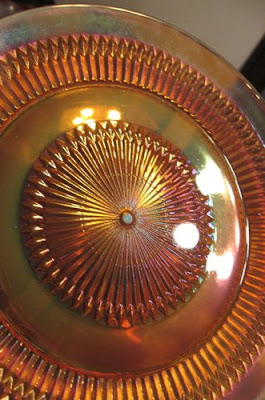
"Hurry, hurry, hurry!-- step right this way, folks, and see this amazing glass. It's molded! Or stretched! It's iridescent! It's just like magic! See all the colors of the rainbow in one single bowl!"
My first exposure to carnival glass was when I was about eight years old, digging in my parents' back yard. At some point, some of the far lot must have been used as a dump by the locals. Because in a day of digging, I'd find things like bits of unlucky G.I. Joes, reflectors from old bicycles, and shards of porcelain... Tiny treasures that rewarded the imagination of a child almost as much as the digging itself did.
In making a mud-pie, one morning, I came upon a fragment of glimmering, shimmering iridescent red-purple glass.
I brought it inside to my mother with wonder in my eyes. To an eight-year-old, it looked about as close to magic as glass ever could. "Look, Mom-- treasure!"
But Mom laughed. "Oh, that's just a piece of carnival glass. It was this cheap, gaudy, cheesy stuff they used to give away at carnivals as prizes. It's nothing."
Except it was too late; I was in love with it.

The Encyclopedia of Carnival Glass, by Bill Edwards and Mike Carwile explains that carnival glass was a type of either pressed or stretched, iridized glass-- typically manufactured between 1905 and 1930. The rainbow iridescence of it was sprayed onto the glass before firing, making it affordable for average households during the area. And, as Mom had said, it was also sometimes given away as amusement park prizes.

The type of carnival glass you have depends on what type of finish was used. Different finishes are layered over a base color. The most common base colors for the glass itself include marigold, amber, amethyst, peach, cobalt, red, and smoke. You can determine the base color of your piece by holding a piece up to a direct light.
According to the book, there are basically three kinds of finishes for carnival glass. One is a satiny finish which adds colored highlights over a uniform glass surface color. This ruffled candy dish, which came from my great-grandmother, is an example of a pretty standard carnival glass piece. The color is marigold and the iridescent highlights tend toward purple/fuchsia tones.

Another type of finish is what was called the "radium" finish. This has a shiny mirror-like luster. In looking at my other carnival pieces from this era, I believe the bowl below might be a decent example of a "radium" look. The finish is very silvery and much more opaque than the other piece. It's over an amethyst glass...

A third finish, typically used on pastel pieces, may have a frosty look-- a white milky edge which is called "opalescent." This delightful Fenton shoe, my friend Josette gave me, appears to be done in the more opalescent style.

While the manufacture of carnival glass originally ended in the 1930s, in the 1960s, companies like Imperial Glass Company of Bellaire, Ohio revived some of their original carnival glass molds. This caused what the Encyclopedia of Carnival Glass describes as a second "carnival glass fever."
And for we fans of the thrift, the wonderful news is that these "revival" pieces are quite findable at thrift stores! While carnival Imperial grape pieces don't come into thrift stores as often as their milk glass sisters might-- a sharp eye can still spot them now and again at very reasonable prices. The pattern of this amber compote was done in blue, as well...

Below is a closeup on a grape pitcher-- in a slightly different pattern to the Imperial grape above-- that I found at the Salvation Army one day for $4...
 I love the depth the iridescent colors give to the raised grapes!
I love the depth the iridescent colors give to the raised grapes!This pressed glass bowl was another Salvation Army find...

You can see the detailed pattern here, and how the colors of the carnival finish accent them. I'm not sure who manufactured this-- I've seen it listed before as Westmoreland Glass, which was a glass making company local to Western Pennsylvania.

The book refers to these highly-defined wheeled patterns as "Starbursts" or "Buzzsaws"...

I actually don't recall the origin of this ice blue basket anymore, but I wanted to share it with you to show how many colors can be found within a single carnival piece...

And lastly, this pattern below is called "Anniversary" from Jeanette Glass Works, another Western Pennsylvania local company. The first is a bowl...

The second is one of a set of dinner plates....
 It was late to the first wave of carnival glass manufacturing-- made in 1947. The Encyclopedia of Carnival Glass considers it "poorly lustered"-- but when these plates catch the light on my dinner table, the glow is as warm and magical as the lure of any Ferris Wheel.
It was late to the first wave of carnival glass manufacturing-- made in 1947. The Encyclopedia of Carnival Glass considers it "poorly lustered"-- but when these plates catch the light on my dinner table, the glow is as warm and magical as the lure of any Ferris Wheel.Hope you enjoyed our little carnival ride today!
- If you missed last Treasure Box Wednesday, where we took a look at a number of thrifted pieces Shiny and Brite, click here.
No comments:
Post a Comment